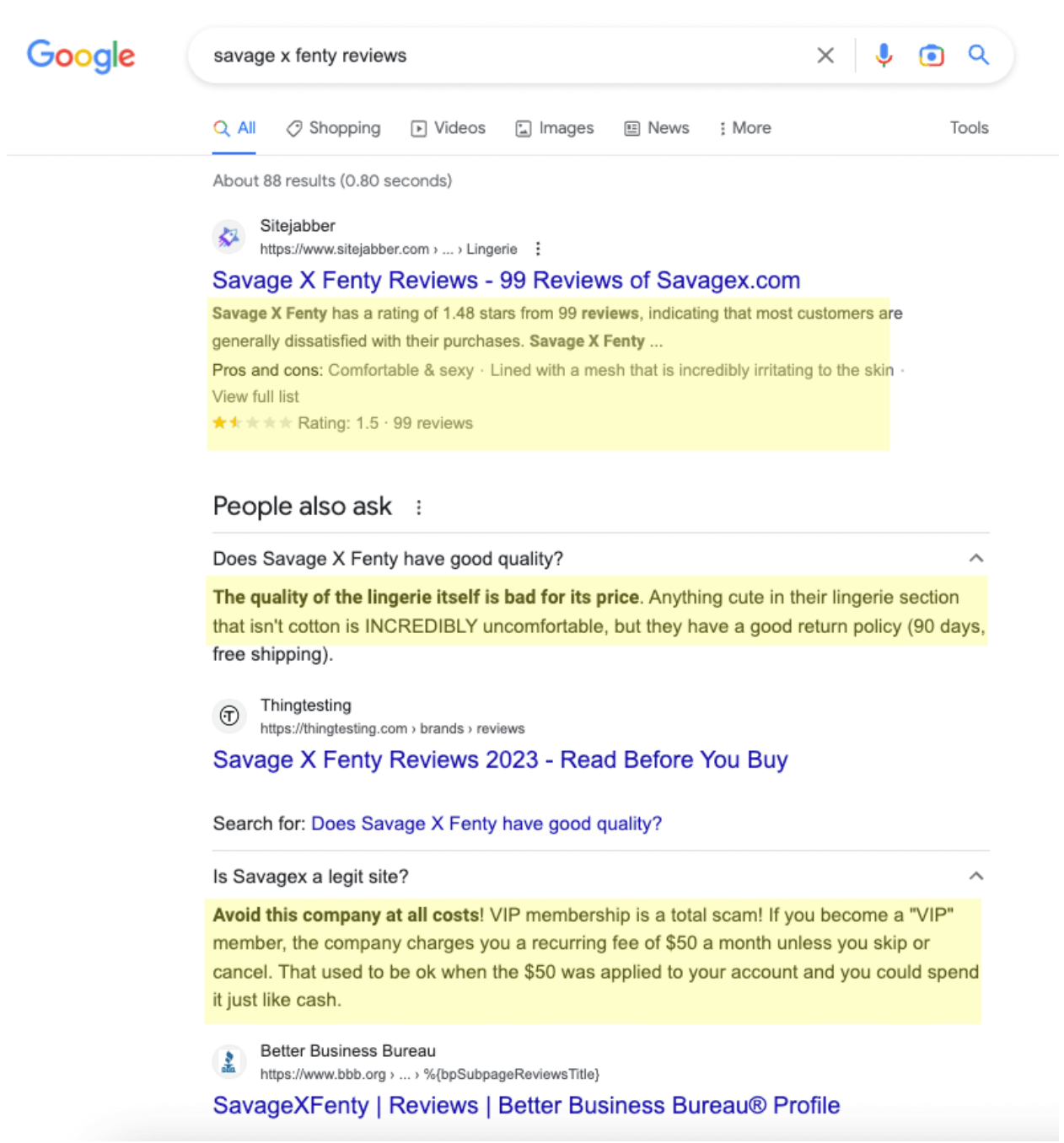
Brand Breakdown: A Fenty Frenzy
Dec 8, 2023|Read time: 7 min.
Brand Breakdown Series
Welcome to the Brand Breakdown series, a monthly deep dive into the marketing strategies of leading global brands.
We’ll be exploring the winning, and losing, strategies that are pushing the boundaries of traditional marketing through the lens of owned asset optimization (OAO), a new approach to building consumer connection.
Subscribe today for unique insights straight to your inbox, exploring how the world’s most recognizable brands are connecting with consumers.
Driving brand visibility with the power of celebrity
Generating buzz doesn’t automatically create a bottom-line impact. This is the main drawback of celebrity branding, where the brand itself runs the risk of getting lost in the public figure’s shadow.
Take, for example, Rhianna and her Fenty brand strategy during Super Bowl LVII. While the event itself may feel like old news, it’s never too late to learn from campaigns of marketing past.
Rihanna’s 2023 halftime show captivated the world’s attention for multiple reasons. It marked her long-awaited return to live performances after a significant hiatus, fueling excitement among her global fan base. She also used this opportunity to make a personal announcement, revealing her pregnancy to the world, and generating even more hype.
A key aspect of Rihanna’s strategy was seamlessly integrating products from two of her brands — Fenty Beauty and Savage X Fenty — into her halftime performance.
By doing so, she effectively showcased the versatility and relevance of her brands, demonstrating the potential for synergy between entertainment and consumer goods.
Capturing attention in the right moments
The halftime show itself was just one piece of the puzzle. Rihanna orchestrated a media blitz surrounding the event, employing a wide range of tactics to generate buzz and engage her audience.
Her approach encompassed social media campaigns, collaboration with strategic partners, influencer marketing, and the release of limited-edition products, among other initiatives.
Rhianna’s performance and subsequent media activities caused her and the associated brands to trend significantly on both social media and organic search. This heightened interest led to an astounding 833% increase in Google searches for Fenty on that day, according to Google Trends.
In terms of social media, Fenty was the most mentioned brand, surpassing all others, according to Sprout Social. The brand received an impressive 16,432 mentions, resulting in over 180,708 engagements and more than 321 million impressions.
This level of visibility and engagement is a testament to the effectiveness of celebrity branding and affinity, as well as the virality of the Super Bowl halftime show itself.
But was the Fenty media frenzy enough to sustain long-term success, or did the celebrity and Super Bowl splash outshine the brand marketing?
When celebrity marketing steals the show
Despite the initial visibility generated by Fenty’s Super Bowl marketing campaign, it faced challenges in focusing that attention on the brand itself, maintaining control over its narrative, and transforming awareness into business impact through authentic consumer connection.
While the event generated massive attention, most of the focus was centered around Rihanna herself and her pregnancy rather than on Fenty Beauty and Savage X Fenty.

This shift in attention highlights the challenge of maintaining control over the brand narrative when the influencer’s personal story takes center stage.
The attention surge that Fenty experienced in the aftermath of the Super Bowl was also short-lived. Looking at the Google Trends data below, we observe that the spike in Fenty search interest only lasted about 24 hours, as opposed to the sustained attention garnered by Rihanna’s personal announcements.

The attention garnered by Fenty during this period was also not entirely positive. The increased visibility led to unfavorable content regarding trust, litigation, and Fenty’s product quality ranking on several branded queries.

When examining the top organic listings in Google at the time, we found that 50% of the top ten results for “Savage x Fenty reviews” were negative.

This serves as an important reminder that heightened visibility can amplify both positive and negative aspects of a brand’s image, necessitating proactive and sustainable brand protection measures built around assets a brand owns and controls.
Beyond branded search, Semrush data showed us that only 8.3% of traffic to Fenty Beauty’s website in February 2023 came from non-branded search.
This illustrates a significant gap in Fenty’s organic market share and overall ability to meet and connect with consumers while they’re researching and before they’re ready to make a purchase decision.
Fenty’s overall lack of market share ownership along with the short-lived nature of the attention surge and the negative content associated with it emphasize the importance of a comprehensive, long-term strategy that can convert awareness into real, positive wins.
Additionally, the dominance of Rihanna as an influencer in the public’s perception further reinforces the need for brands to strike a balance between leveraging celebrity partnerships and maintaining a strong brand identity that shows up throughout a consumer’s entire journey.
Super Bowl-sizing marketing impact with OAO
In her recent campaign leveraging Super Bowl LVII, Rihanna undoubtedly drove an impressive amount of attention to Fenty Beauty and Savage X Fenty. Through limited edition products, influencer partnerships, and strategic collaborations with Ulta and Sephora, she achieved great results.
But brand buzz doesn’t automatically drive real business impact. By taking an owned asset optimization (OAO) approach, Rhianna’s retail brands could have better capitalized on the visibility generated by her performance and created tangible consumer connections throughout the buying journey — a prerequisite for conversions and revenue.
An OAO strategy organizes and aligns a brand’s assets across the MACH-6, putting owned assets first to ensure a consistent message throughout the customer journey, from the research phase to the evaluation of brand trust signals like reviews and testimonials.
Instead of focusing on developing and optimizing a network of owned assets to provide long-term value, Fenty’s marketing efforts surrounding the Super Bowl leaned on leveraged and managed assets, including Rhianna herself, to amplify point-in-time reach.
While Fenty products are often listed on third-party partner retailers and included in lists of recommended products by online publishers, the brand has little-to-no control over the content those sites publish.

This, as we learned, meant that the visibility generated by Rhianna’s performance amplified both positive and negative content published about the brand. And while Rhianna’s star power certainly brought the hype, brand awareness seldom equates to business impact by itself.
Seeing OAO as a difference-maker
With an OAO approach, Fenty Beauty would align and optimize their assets to meet varying consumer needs and create content that matches the intent of the consumer, positioning itself as a trusted resource and consumer guide.
By focusing on what they own and can control, Fenty could ensure consistency, relevance, and overall impact of their messaging throughout the rest of their digital ecosystem, and throughout each consumer’s unique journey.
In Rhianna’s case, this network of touchpoints would have resulted in more reach, higher trust, and better control over what fans saw when they searched for the brand before, during, and after her Super Bowl performance, turning the massive buzz into opportunities for connection and conversion instead of questionably-qualified attention.

Ultimately, OAO helps brands strategically optimize and align their digital assets around controlled, intentional messaging, ensuring they show up earlier and more often throughout a consumer’s entire journey.
By building a persistent, far-reaching network of consumer-focused assets, brands like Fenty Beauty can transform attention into connection, capitalizing on increased awareness not just during events like the Super Bowl, but every day as thousands of consumers turn to Google for answers.
These brand touchpoints connect with consumers, building trust, loyalty, and long-term relationships that drive real business outcomes.




